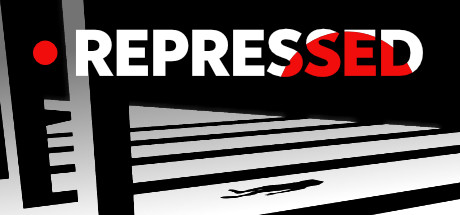Therapy’s but a walking shadow, a poor player falls through the stage… It is a tale full of sound and light puzzles, signifying nothing.
Type: Single-player
Genre: Adventure, Puzzle Platformer
Developer: Sigur Studios
Publisher: ARP Games
Release date: 26 September, 2019


Morose in Monochrome
The increasing ease of publishing small indie games has led to the rise of a subgenre of “dark psychological indie” titles like Limbo or Gris or basically any “walking simulator” game. Repressed understands that most of those games use vague symbolic situations and art styles to convey their themes in a manner that begs their players to consider their themes without directly telling the players what they are supposed to be thinking, and Repressed thinks those games are cowards.
Repressed starts you off by directly telling you that this is a game about psychology because the voiceover lady is psychologist Dr. Voiceover Lady and You are in an “innovative psychological approach” that involves putting patients in a mostly monochrome world, except all the important memories are red. Is this VR or some kind of hypnotism? Who knows, who cares, the important part is that the game is built around light and shadow puzzles, so there’s an in-universe excuse for it. Also, the You that you control is a shadow with a cube as a head.
Among indie games, having an art style that reinforces the themes of the game, while also being far more easy and inexpensive to actually make than attempting to compete with billion-dollar AAA studios has been a trend for good reason. A game like Limbo conveys its oppressive and foreboding atmosphere with a palette of dark greys and blacks better than a colorful world would have, while also making “drawing textures” for the solid black silhouettes a much simpler task for the one or two people who actually make the art assets.
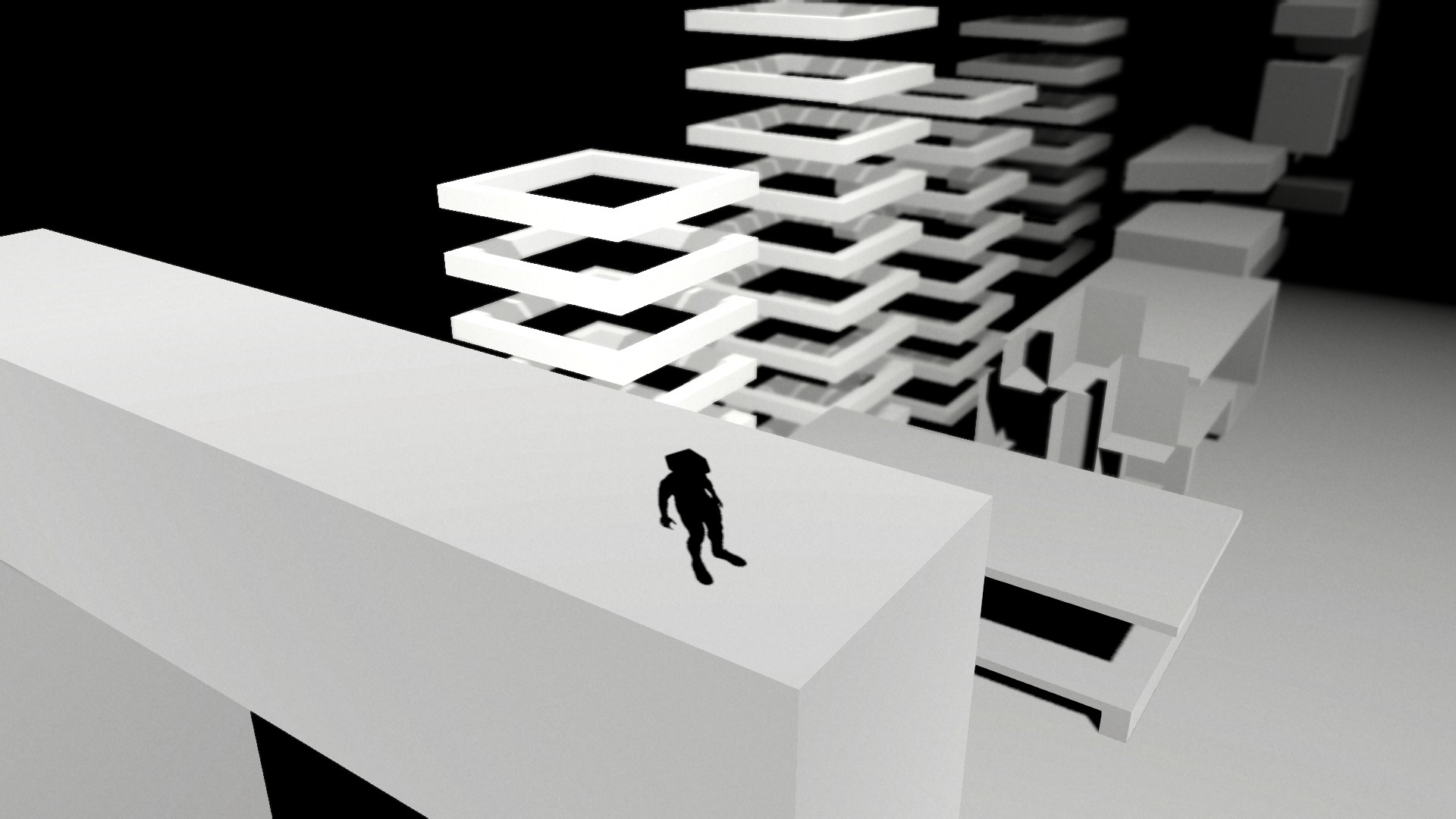
At one point in the game, Dr. Voiceover tells you what she thinks of the solid white, regularly-geometrically-angled pathways as being “like an art gallery”, and at another point, says that it is shaped this way because the brain makes neural connections in similar fashions. Maybe it’s true, some of the jumbled rectangular blocks connecting at right angles hanging off the sides of the pathway you follow are reminiscent of Modern Art or Art Deco pieces… but does that really work in service to the game’s themes? By what Dr. Voiceover says, literally any brain would look that way, so the topography of the “mind palace” you explore actually has nothing to do with the repressed traumas You are exploring. Dr. Voiceover may tell you that you’re now entering some area that represents some more buried trauma, but the actual game area you play in looks exactly the same as every other one – a completely clinical-white area filled with geometric objects that convey no meaning to interpret. This isn’t a terrible idea, it’s the basis of a very good idea, it’s just not used to actually help tell the story that the game is trying to tell.
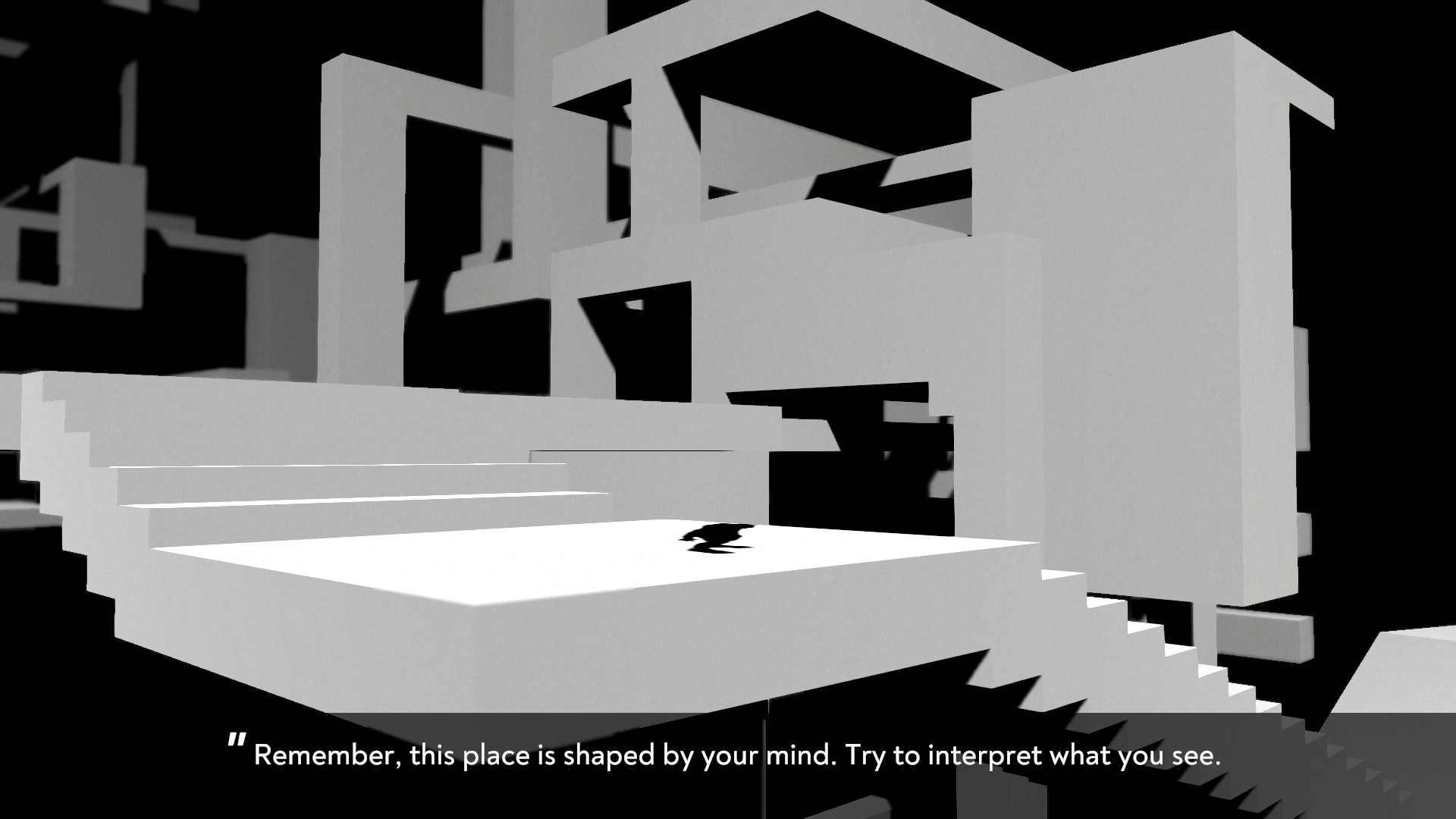
While I have to avoid spoilers to avoid giving away the whole purpose of playing the game, at an early stage, you come across a red humanoid figure with a dress on. Dr. Voiceover then tells you that this is Your fiancee, a beautiful woman. Uh, sure, if you say so, Dr. Voiceover Lady. In spite of the fact that Dr. Voiceover tells you that this is a psychological landscape inside Your own mind, nothing in this landscape conveys Your emotional state. Nothing is shown, everything is told. This is made even more annoying when you will see something like, as a hypothetical example not to spoil anything, you’ll see a glass of apple cider, and Dr. Voiceover lady will tell you that apple cider is Your favorite drink… only for the dramatic reveal 10 minutes later that You actually hate apple cider! Also, You apparently didn’t know this, and need someone to tell you when you have strong psychological aversions to things. I guess having something like a foreboding miasma around the drink you don’t like to clue you in that you don’t like it would be too much to ask for. The core problem is that this is meant to be a mystery, but there is precious little for you, as a player, to think about between times that Dr. Voiceover comes in to tell you what You think about everything. Because of that, you don’t feel drawn in to wonder about the mystery, which is where the fun of mysteries come from. You’re given no reason to engage, and therefore, no reason to really care.
Press F to reveal shocking swerve
The actual gameplay you engage in mostly involves going along a largely linear path. The path is broken up by needing to make a few “jumps” (in actuality, you can’t jump, but running off a ledge lets you keep momentum and there is no fall damage), and by shadows. A major gameplay mechanic is that if Your shadow feet touch a shadow, you instantly lose all momentum and fall through the ground. (All ground, even if there were a ledge below you with no shadow on it, you keep falling.) After falls to the bottom of a zone, you get warped back to a checkpoint. Checkpoints past maybe the first few areas are generally close enough together that you don’t miss much, and you can even jump off just to warp back to the checkpoint if you’ve gotten into a dead end to save time in places.
While you follow that mostly linear pathway with a few branching dead ends, there are occasional puzzles involving the ability to rearrange the direction light comes from, causing the shadows to change position. (Dr. Voiceover announces this by saying that you can alter your memories. I’m not sure that simply changing the lighting counts as altering memories, but isn’t deliberately altering memories in search of “repressed memories” exactly what leads to horror stories of psychologists convincing people they were molested as a child by trusted family friends when they actually weren’t?) You also push buttons to open new paths, sometimes taking advantage of casting shadows to “project” your torso across a gap to a lower platform. In some areas, short fog distance or floors that slide into place only when you are nearby create a basic maze. There are some block-pushing puzzles, as well. Basically, outside of the shadow gimmick all the gameplay is built around, some standard time-filler puzzle material. In story-based games like this where you are given vague clues to think over, the time spent solving puzzles or just wandering through the mazes is time you can spend reflecting on the clues you’ve been given and how they fit in with what you already know, but since Dr. Voiceover tells you exactly what to think about everything, it’s just dead time.
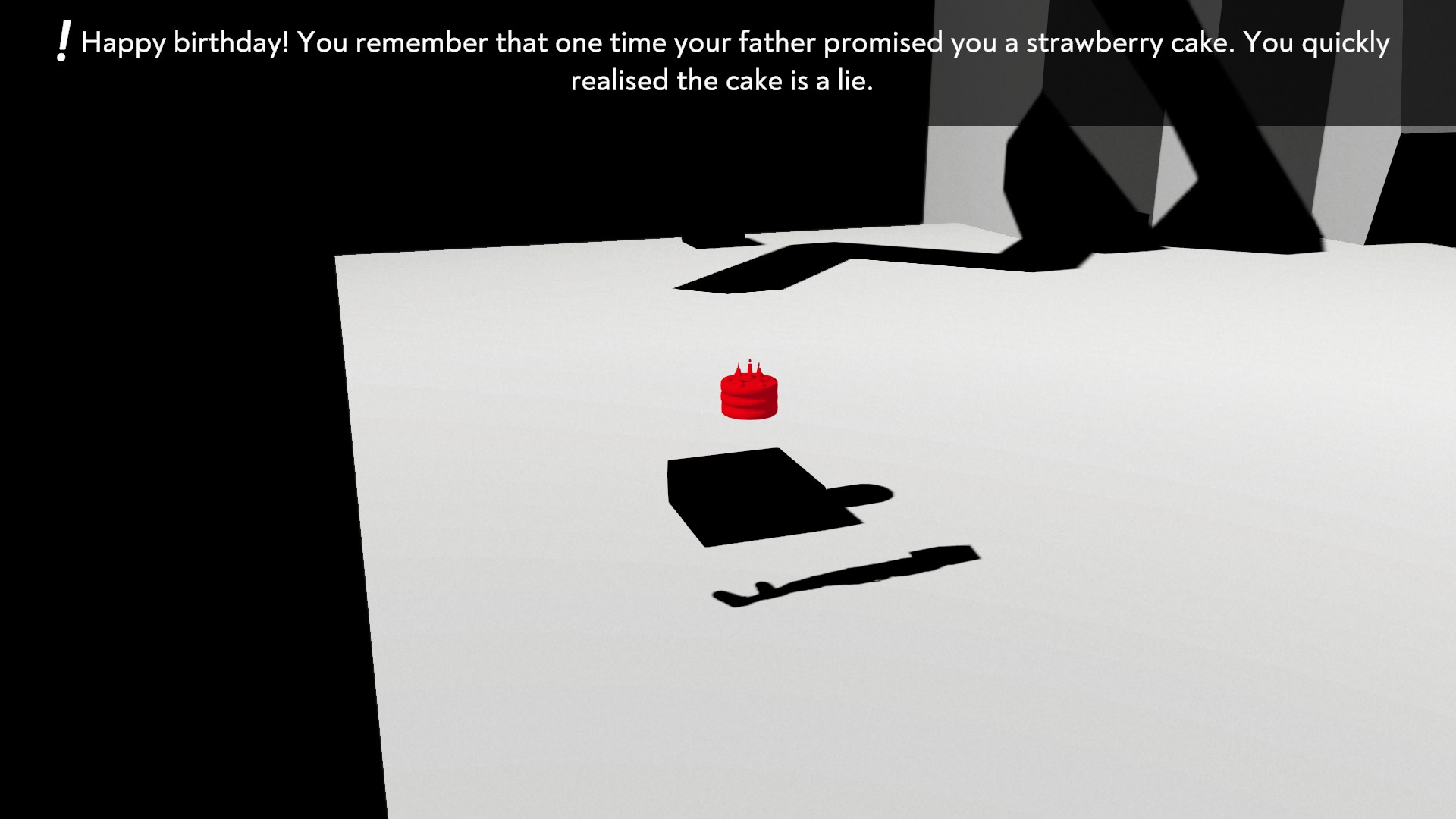
This is exacerbated by the hidden memories that make up the achievements. There are hidden collectibles in the hard-to-reach crannies or areas that require leaping off into the “scenery” to find, which fill up a “memory palace” where they are given captions, as well as giving you an achievement for finding each of them. This could be used as a game developer’s trick to get players to focus upon the scenery and details of the world where they would otherwise be tempted to rush through a linear area just to get to the next soundbite, but the problem with it in this game is that there’s nothing else to occupy your time or mind, so you spend most of the game thinking more about where a cheevo could be hiding rather than the mystery you are supposedly solving. At one place, I even managed to fall to a location that accidentally triggered a big reveal of The Bad Thing that supposedly caused the repressed memory in the first place, only to not actually see it because I was respawning.
That said, there are a few technical problems I had with the game. The game first loads onto a screen where it plays what I guess is supposed to be eerie discordant music, but it’s painfully loud and won’t stop until you start the game. Going into options, there is only a setting for master volume, music, and SFX. It turns out the voiceover that composes most of the game is counted as a ‘sound effect’ alongside the footsteps or wind noises. Without adjusting the music down to 20% volume, I wouldn’t be able to hear Dr. Voiceover at all.
Also, restarting the game (which is the only way to go back a section) means all your collectibles disappear and you need to recollect them. Miss one, and to have a complete memory palace, you need to collect them all again from the very start of the game. It really could use a chapter or section select screen.
Beyond that, the game is technically quite competent. I found a few places where joints in the walls made weird black squares flicker in and out, or a place where I could walk through shadows without falling like I was supposed to, but the game generally works as intended just fine.
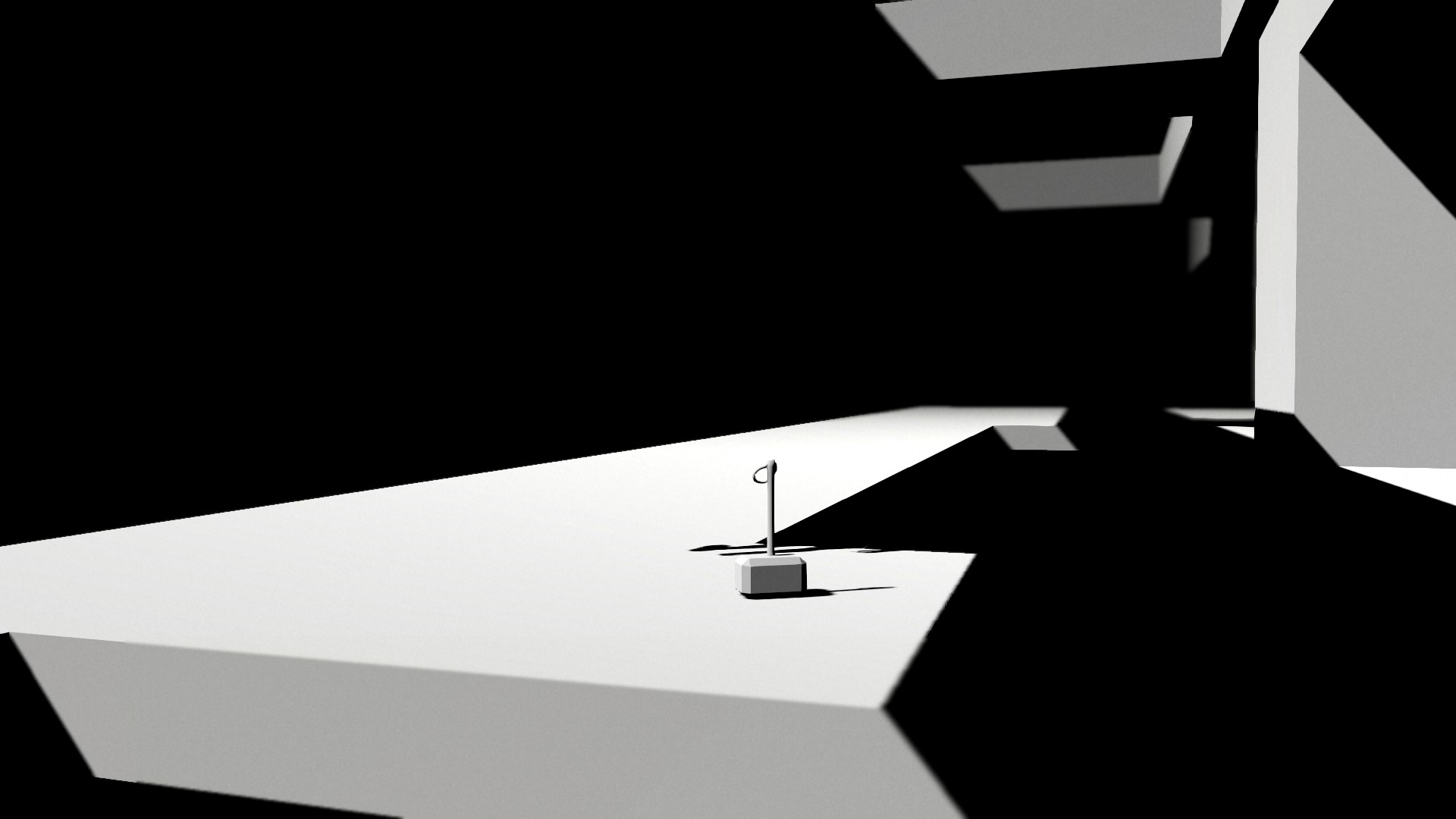
Eight Deadly Words that kill any story
I don’t care what happens to these characters.
Throughout this review, I’ve kept a separation between “you” as a player and “You” (capital) as the nameless protagonist of the game. The game doesn’t seem to want to make a distinction between the two, but the distinction is undeniably there. Even beyond the most obvious problem being that if I had repressed memories, odds aren’t great they would be these memories, there’s the problem that you, as a player, are constantly discovering (meaning, being directly told) what You feel about different objects, only to be told it was a lie and have it change. The cold and isolating landscape “inside the mind” of You gives little impression of what sort of person You are, which makes it very hard to care what’s at the back of Your mind. A game like Silent Hill will make the protagonist a character unto themselves, even as you guide their actions. By making the characters relatable, you care what happens to them, even if they’re not “you”. Some games like the Choice of Games “Fallen Hero: Rebirth” will have you as a supervillain plotting a crime because of Your Dark Past that you get to select from multiple-choice, and so they aren’t entirely your choices, but you can at least feel invested in having made some kind of choice. This is a story where you’re just told You are responsible for The Bad Thing, but you don’t feel you have anything to do with Your past. As a player, you push a shadow through a sterile world from one setpiece to the next while being soothed that you shouldn’t be scared of the empty white hallways with nothing to be afraid of, or to focus on the details in a world utterly devoid of any.
This could be much better by simply changing the world from being a sterile geometric one to one that conveys the emotional state of You. If, for another hypothetical example, You were traumatized by a fire, then black flames might come out and encroach upon the path, destroying things as you have to run through the disappearing path to get to the next area. The thing you are told You are afraid of would then interact with the game world in some shape or fashion. The only way that the gameworld reflects the story is in the music, where the discordant music sometimes plays near the events related to The Bad Thing. (It is weirdly localized, however, so it grows louder or quieter when going up and down maze paths depending upon distance to the event location as the crow flies.) They could have made the shadows mean something relevant to Your story, rather than just being something associated vaguely with any and all memories. (Yes, hypothetically, there may be some implied deeper meaning I missed, but this is a game where they feel the need to have Dr. Voiceover directly tell you whether You like puppies or not, so I doubt they’re going to slip something in that is so vague.)
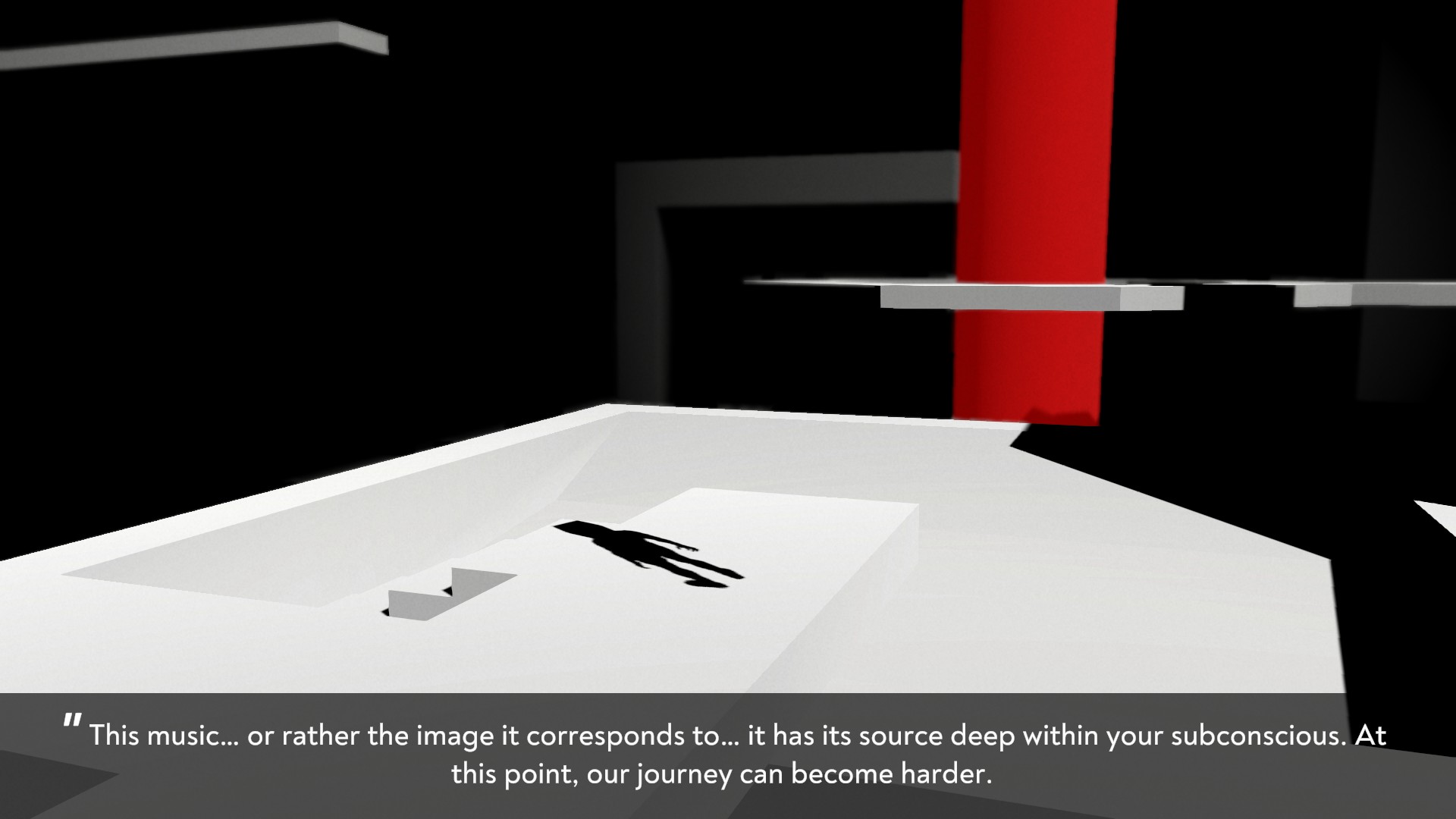
The story is also dragged down by an attempt to be as generic as possible. Nobody but Dr. Voiceover has a name, they’re just “the fiancee” or “the father”. Presumably, this is in an attempt to be relatable on some level, in the same way that you’re playing as “You”, but as previously mentioned, that falls flat when your experiences are so different from Your experiences. Characters are raw archetypes portrayed without nuance, either pure good or evil. (Although I suppose that’s the one area where simplistic black-and-white graphics actually DO convey the themes of the story…)
There’s a point near the end where I thought the recurring discordant music was going to turn out to be sweet music altered in your own consciousness and revealed the music to be a pleasant classical tune… but nope. The game ends on an anti-climax resolving nothing. Perhaps they really wanted to hammer the idea of “therapy session” as a theme even harder? Regardless, I guess that shows me for trying to think about whether this game has themes or not.
Verdict
It’s a shame this wasn’t a more engaging game. Everyone was clearly doing their jobs and making the pieces of the game well in their own little corner. The problem is that the person writing the story and the person making the game never talked to each other and worked out how one should shape the other. Overall, the game you explore is utterly devoid of emotions as Dr. Voiceover tries to tell you how emotional you’re being. There’s this fundamental segregation between the story being told and the game you’re playing that only drifts further apart over time. The more Dr. Voiceover has to tell me what everything means because there are no clues in the game for me to follow myself, only to then shockingly reveal she was lying the whole time, the more tuned out to the whole story I become. And this is a purely story-driven game, no mistake about it, so that’s fatal to this game.
Repressed isn’t likely to be one of the indie darlings remembered within the niche audience that remembers games like Limbo fondly, but it shows all the signs of technical competence that mean these same people could easily make another game with higher ambitions. If only the shadow puzzles could have anything to do with the story being told, and the game had abandoned its so-clinically-detached-from-the-emotions-of-the-character-you-need-a-telescope-to-see-them design choice, this could have been a great game.
If you nevertheless can’t get enough of this kind of mystery-exploring game, it’s a two- or three-hour story running on a competent game engine. If you get it cheap, you can at least ram through it quickly enough to feel disappointed it wasn’t more rather than disappointed you wasted your time.

